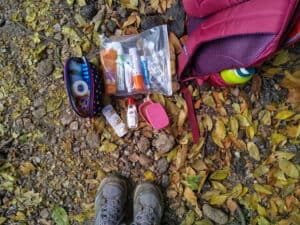If you’re like me, there’s nothing better than hitting the trails for a day hike. It’s the perfect way to escape the hustle and bustle, get some exercise, and take in the beauty of nature. But, to make the most of your outdoor adventure, you’ll need to be prepared. However, to ensure your outdoor adventure is top-notch, it’s crucial to be ready with some excellent day hiking tips.
Essential Gear for Day Hiking

When venturing out on a day hike, there are several items you’ll want to make sure you’ve got in your pack. It’s all about balancing weight and usefulness – you don’t want to overpack, but you want to ensure you’re prepared for a variety of scenarios.
First off, a sturdy, comfortable backpack is paramount. Your pack will be carrying all your essential items and needs to be easy to carry for several hours. Look for something lightweight, with adjustable straps and plenty of compartments for easy organization.
Next is proper clothing and footwear. You’ll want clothing that suits the weather and terrain you’ll be hiking in. Layering is the best approach. It allows you to add or remove as needed. As for footwear, a good pair of hiking boots or shoes is a must. They should be comfortable and provide good ankle support.
Don’t forget about food and water. Carry enough to sustain you for the whole hike. A tip I’ve learned over the years, always carry a little more than you think you’ll need.
Last, but surely not least, pack a first aid kit. Accidents can happen, and it’s best to be prepared. The kit should include band-aids, antiseptic wipes, tweezers, and bug spray. If you’re hiking in an area known for ticks, consider including a tick remover tool as well.
Remember, hiking isn’t merely about pushing your physical limits, it’s also about appreciating nature’s beauty and making memories.
Every item you place in your backpack should have a purpose. It’s about bringing only what you’ll need, and leaving behind what you don’t. So, take a moment to think about your hike and what’ll be most important to you.
We’re not stopping here, as there’s still much to explore, like the importance of understanding and respecting wildlife, getting to know how to navigate, and more. We’ll delve into these topics in the next sections.
Planning Your Day Hike

Now that we’ve gathered our essential gear, it’s time we plunge deeper into the process of planning a successful day hike. Proper planning not only ensures you have a fun and safe hike, but it also means respecting nature and leaving no trace behind.
First off, choose your trail wisely. Your choice of trail has a direct impact on the overall hiking adventure. Knowing the trail length, elevation, difficulty level, and accessibility are key to matching it with your physical capabilities and experience. Never forget, it’s your hike – your comfort, safety, and enjoyment should be the priority.
Check the weather forecast beforehand. This is not a step to be overlooked! Bad weather can ruin a hike and in the worst case, turn it into a dangerous event. Different trails and terrains respond differently to weather conditions. A little research can save you from slipping on a muddy trail or getting lost in fog.
Here are a few more essential planning tips to keep in mind:
- Pack according to the weather and the complexity of your trail. Apart from the essentials, consider taking a map or GPS, insect repellent, and a camera to capture the mesmerizing views.
- Plan your timing – calculate how long it’ll take you to hike the trail, considering your speed and the terrain. Add extra time for meals, rest, and the unpredictable.
- Let someone know your trail, the approximate time you’ll be back – it’s a simple safety precaution in case anything goes wrong.
Proper planning for your day hike ensures that you’re prepared for whatever comes your way. But remember, part of the charm is just being out among nature. So relax and enjoy the journey. It can be as rewarding as reaching your destination.
Remember, hiking is not just about climbing a hill or descending down a path. It’s about immersing yourself in nature, understanding its beauty, and embracing the peace it brings. In our next section, we’ll delve deeper into how to make your experience beneficial and memorable, with respect to handling wildlife encounters and navigation techniques. Make sure to read on.
Choosing the Right Trail
The trail you choose can make or break your day hike experience. It’s about more than just picking a path in the woods–it requires considering factors such as length, elevation, difficulty, and accessibility.
So, how can one choose the right trail?
Length: This seems pretty clear-cut, but it’s actually dependent on your own abilities and the time you have available. As a novice, aim for trails that are short – around 1 to 3 miles. Once you’re comfortable with that, gradually increase the length.
Elevation: It’s important to consider this when planning your trip. The elevation can have a significant impact on the hike’s difficulty. If you’re not accustomed to high elevations, inadequate preparations might lead to fatigue or altitude sickness.
Difficulty: Trails vary in difficulty—the level of difficulty depicts the steepness and the terrain. Easy trails have gentle slopes and are often well-maintained while challenging trails are steep and may require scrambling over rocks. Pick one that suits your fitness level.
Accessibility: Finally, check how accessible the trail is from your location. Time spent in the car is time taken away from your hike!
By considering all these factors, you’ll be ensuring a successful day out in nature rather than a grueling challenge or disappointment.
Next, we’ll delve into another important aspect of hiking…watching the weather.
Dressing for the Outdoors

When heading out for a hike, it’s crucial to dress appropriately. Your clothing has a significant impact on your overall comfort and safety. There’s a basic adage in hiking circles, “cotton kills”. Cotton clothing, while comfortable, tends to absorb and hold onto moisture. This could end up making you feel chilly, even in mild weather. Instead, opt for synthetic materials or wool when choosing your hiking outfit. These fabrics dry quickly and provide better temperature control.
Layering is also a valuable technique for outdoor dressing. It’s much more effective to wear multiple light layers that can be added or removed depending on the weather, rather than one thick piece. Start with a moisture-wicking base layer to keep your skin dry. Add an insulating mid-layer like a fleece jacket for warmth. Top it off with a weather-resistant outer layer to protect against wind and rain.
Don’t forget about your feet! They’ll be doing most of the work during your hike. Select a pair of sturdy, well-fitted hiking boots. They’ll provide the necessary support and protection for your feet and ankles. Additionally, choose moisture-wicking socks that work in concert with your boots to keep your feet dry and blister-free.
And lastly, always bring a hat and gloves regardless of the season. A hat can shade your face during summer, or help retain body heat in cold weather. Gloves can protect your hands from blistering hiking poles or sudden temperature drops.
Seemingly small decisions like these can make a world of difference in your hiking comfort. In the following section, we’ll move onto other aspects of hike preparation, which will ensure your experience with nature is as enjoyable as possible.
Staying Hydrated and Nourished on the Trail
There’s no denying the critical role that hydration plays in hiking. As the activity can be quite demanding, you’ll be losing fluids as fast as your body is consuming them. For this reason, always bring more water than you think you’ll need. It’s a common rule of thumb to have at least one liter for every two hours you plan to be on the trail. However, this can vary based on the intensity of the hike, the weather, and your personal needs.
When it comes to nourishment, it’s equally important to fuel your body correctly. Stay away from high-sugar foods that lead to an energy crash. Instead, go for nutrient-dense snacks like nuts, seeds, dried fruit, or jerky. These kinds of eats can give a sustained energy release ensuring you avoid those nasty slumps that can happen mid-hike.
Regardless of what snack you choose, always remember to pack more than you think you could consume. It’s much better to finish the hike with leftover snacks than to run out midway and risk becoming fatigued. Also, you should keep in mind the “Leave No Trace Principle”. So, don’t forget to pack sealable bags to carry empty wrappers and leftover food waste. Leave the trail as clean as when you found it. It’s a sign of a responsible hiker and it helps preserve nature for everyone.
Sufficient hydration and nutrition are vital for a successful and enjoyable hike. By planning and preparing in advance, you can ensure your body is well-equipped to face the demands of the trail. The next part of this article will delve further into hiking safety. Keep reading to learn about some essential safety tips every hiker must know.
Safety Tips for Day Hiking

While hydration and nutrition are critical for a successful hike, safety cannot be overstated. Here are several safety measures worth bearing in mind.
Consider the right gear. Proper hiking boots protect feet from rough paths while providing the necessary ankle support. Don’t overlook clothing; opt for layers allowing for quick adjustment to temperature shifts. It’s also advisable to have rain gear in your pack; you never know when the weather might change.
Preparing for emergencies is paramount. Always have a first aid kit on hand, and know how to use it. It should include bandages, antiseptic wipes, tweezers, and any personal medication you might need.
Educate yourself about the trail before starting your hike. Understanding the terrain will help you avoid sudden drop-offs or unstable surfaces. It also allows a better estimation of time and effort required, enabling smarter planning and pacing.
Remember, day hikes mean the sun is up and with it, harmful UV radiation. Protect your skin with a broad-spectrum sunscreen with an SPF of at least 30, and a cap to protect your scalp and face.
Wildlife contact should be minimal to avoid untoward incidents. Remember, we are visiting their home. Understand the prevalent wildlife in your hiking area and be prepared on how to react in possible encounters. Remember, feeding animals is strongly discouraged.
While we’re hoping for an incident-free hike, it’s essential to let someone know about your plans. Give them a copy of your hiking route and a timeline. If something goes wrong, they’ll know where to start looking.
Following these tips should enhance your hiking safety.
Conclusion: Essential Day Hiking Tips for Safety
As we’ve delved into day hiking tips, it’s clear that safety takes precedence. Armed with the right gear, knowledge of the trail, and a solid plan, you’re ready to tackle any trail. Remember, your hiking boots and clothing layers are your best friends when it comes to tackling varying terrains and temperatures.
Don’t forget your first aid kit. It’s your safety net when minor injuries occur. Sun protection isn’t just for the beach; it’s vital for day hiking too. And while wildlife can be fascinating, minimal contact is best.
Lastly, always let someone in on your hiking plans. It’s a simple step that can make a world of difference. So, lace up those boots, pack your essentials, and hit the trail with confidence. Safe hiking!


